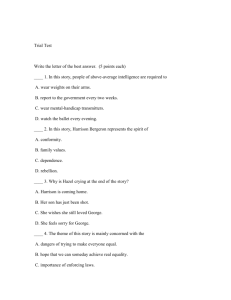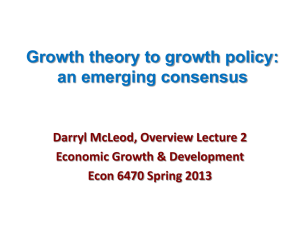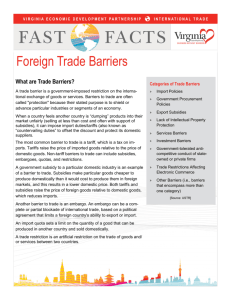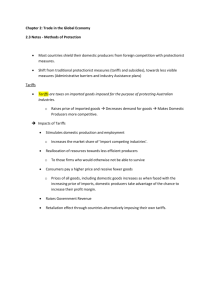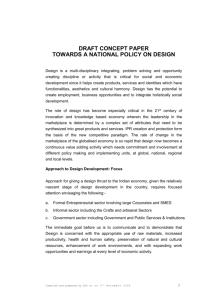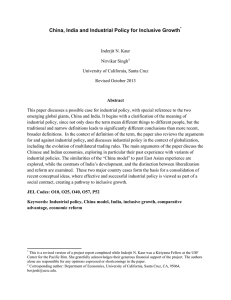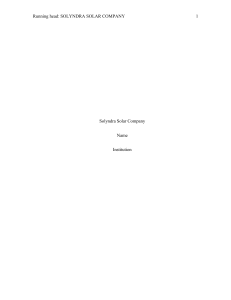What is “smart” industrial policy? Can it be done successfully
advertisement
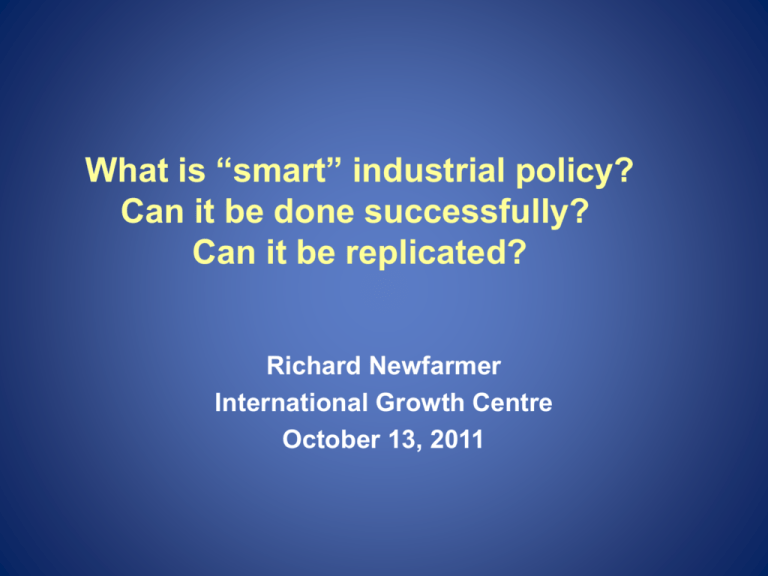
What is “smart” industrial policy? Can it be done successfully? Can it be replicated? Richard Newfarmer International Growth Centre October 13, 2011 What is industrial policy? • Definition – “Any deviation from sectoral policy neutrality…or deviation from laissez faire” – “Policy attempts to alter the structure of production …” – Policy interventions to tilt market prices in favor of one activity over another • Instruments (“hard IP”): – Tariffs – Tax breaks – Subsidies through the budget (including special programs, procurement) – State enterprise pricing – Subsidized credit programs • Instruments (“Soft IP”) – Standards – Export promotion – Infrastructure Two conclusions ex ante: • All countries have industrial policies (though they may not call it that) • Industrial policy to support one activity comes at the cost of penalizing other activities – particularly “hard” IP Many different objectives… • Promote growth (including “competitiveness”, productivity) • Other objectives, sometimes as vehicles to growth: – Moving into higher value added products – Trade: Exports and import substitution – Innovation – Local employment – Protecting the environment Not unusual: Programs often have multiple objectives, and many times lack quantifiable indicators of success. Economic rationales for government intervention center around “market failures” • Latent comparative advantage: The sector protected through industrial policy should soon be able to survive without protection • Externalities: firms underinvest because they don’t capture spillovers to other activities • Lack of appropriability: firms underinvest (in technology or export searches) because new entrants using the technology will soon erode profits • Informational asymmetries: government + private sector • Complementarity between goods and inputs such as infrastructure • Agglomeration economies: Silicon Valley, Bangalore, clusters • Imperfect competition in product markets and capital markets Does industrial policy work? • Dani Rodrik (2004): Yes • “…it is not surprising to observe that industrial restructuring rarely takes place without government assistance. Scratch the surface of nontraditional export successes anywhere in the world and you will more often than not find industrial policies, public R&D, public support, export subsidies, preferential tariffs arrangements, and other similar interventions lurking beneath the surface” (2004). • Pack and Saggi (2005): No “[In recent industry successes], public interventions have played only a limited role. Moreover, the recent ascendance and dominance of international production networks in the sectors in which developing countries once had considerable success implies a further limitation on the potential role of industrial policies. Overall, there appears to be little empirical support for an activist government policy even though market failures exist that can, in principle, justify the use of industrial policy.” Yes and no = Yo Harrison - Rodriguez Clare (2010) review of many studies: “Soft” industrial policy has higher success rate… “Hard” industrial Policy: ? – Tariffs – Subsidies to specific sectors – Tax breaks for foreign investors – Domestic content requirements Soft” Industrial Policy: √ – Special Economic Zones offering lower cost infrastructure – Roads and ports designed to increase trade – Special Credit for exporters (Trade Credit) – Promoting clusters in order to export Source: Ann Harrison, “Growth Week” International Growth Centre Sept, 2011 …and increasing exposure to trade competition is a common element of success… “…trade and FDI policies have generated the greatest welfare gains when they are associated with increasing exposure to trade… interventions that increase exposure to trade (such as export promotion) are likely to lead to higher welfare gains than other types of interventions (such as tariffs or domestic content requirements).” Source: Harrison and Rodriguez- Clare, 2010 Aid for trade …about 20% of WTO case stories concerned some form of industrial policy Private Trade Sector Facilitation 19% 18% Industrial Policy 17% Building Capacity 25% Up-grading quality: Brazil’s projects in Cotton 4; tea in Rwanda; fish in Grenada Spur new products: organic coffee in Guatemala; phones to ladies in Bangladesh Infrastructure 5% Improving Policy 16% All increased exposure to trade competition and to learning economies from exporting What you promote matters… • Some advocate focusing on specific sectors: – Target emerging sectors (Clemens and Williamson 2001) – Target skill-intensive sectors (Nunn and Trefler, 2006): – Manufactured exports (Easterly et al, 2009) – But… this literature routinely overlooks agriculture and services – and focus of policy depends on each country • Other focus on types of activities: – Rodrik (2004): only new activities (and not sectors) – Harrison- Rodriquez Clare: activities with spillovers – Rodrik (2008) suggests under-valuing the exchange rate to promote tradeables – Aghion, et al (2011): promote into competitively structured sectors How you promote matters even more… 10 principles of “smart” industrial policy 1. Begin: removing policy, institutional, and cost elements in the value chain that limit production and exports 2. Transparency: Quantify amounts in budget to parliament; begin by quantifying the industrial policy you have 3. Incentives/subsidies: Should be provided only to “new” activities 4. Objectives: clear with benchmark/criteria for success and failure 5. Sunset clause: phase out subsidies automatically over say 3 years 6. Projects should entail private risk commensurate with public risks 7. Competition: Avoid raising barriers to entry and import competition 8. Agency administering IP: must have demonstrated competence – with clear political oversight and accountability 9. Ministry: Maintain channels of communication with the private sector 10. Evaluations: Subject portfolio to regular ex post external evaluation • Costs turned out to be higher than anticipated • Prices of silicon panels fell dramatically from 2008 highs • “…to put Americans back to work…reduce dependence on foreign oil…rewable energy…create millions of new jobs…a new green energy economy” Both China and US rival First Solar sell at 25% of the per watt cost of Solyndra’s technology • DOE program, created in 2005, had excess uncommitted funds.. • “DOE take steps to ensure risks are properly mitigated…performs due diligence” Solyndra goes for scale, and cash out investors through IPO. • But company ceased operation on Aug 31, 2011 • DOEs program head resigns • Some US Congressmen call for protection against China Solyndra’s cautionary tale • • • • Chu announces $535 loan guarantee to Solyndra for its cylindrical solar photovoltaic cells (March 2009) “shows speed at which the DOE can operate when barriers to success are removed…” Lessons: • Even with DOE/OMB checks, (a) business plans subject to considerable uncertainty, and (b) politics can trump good financial analysis • But: Program did not curtail competition, and so prices to downstream buyers were not adversely affected…and losses were limited • Transparency helped hold political authorities accountable So… • What is smart industrial policy? – Focus on removing obstacles & creating incentives – Those measures that abide by the 10 principles – Especially, competition, transparency, and sunset clauses • Can it be done successfully? – Yes, but soft industrial policies tend to have higher success rates than hard policies – Ojo: Little conclusive evidence that industrial policy by itself explains high rates of growth of the fastest growing countries • Can it be replicated? – Yes…and since bad experiences can be replicated along with the good, caveat emptor References and Further Reading Aghion, P., M. Dewatripont, L. Du, A. Harrison & P. Legros «Industrial Policy and Competition” June 28, 2011 Nolan, Marcus and Pack, Howard, 2005. “The East Asian Industrial Policy Experience: Implications for the Middle East”. Working Paper Series, 05-14. Washington DC: Institute for International Economics Harrison, Ann and Andres Rodriguez-Clare (2010) “Trade, Foreign Investment, and Industrial Policy for Developing Countries” NBER Working Paper 15261. Pack, Howard and Saggi, Kamal, 2005. Is There a Case for Industrial Policy? A Critical Survey. Oxford Journals, 21:267–297. Oxford University Press Rodrik, Dani, 2004. “Industrial Policy for the Twenty-First Century”. Discussion Paper Series No. 4767. Rodrik,Dani, 2008. “Normalizing Industrial Policy”. Commission on Growth and Development Working Paper No.3.



